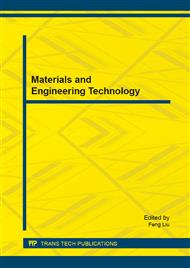[1]
L. Ding, H. -N. Wang, Z. -H. Guan, and J. Chen, Tracking under additive white Gaussian noise effect, IET Control Theory & Applications, 4(11) (2010) 2471–2478.
DOI: 10.1049/iet-cta.2009.0449
Google Scholar
[2]
X. -S. Zhan, Z. -H. Guan, R. -Q. Rui and F. -S. Yuan, Optimal performance In tracking stochastic signal under disturbance rejection, Asian Journal of Control, 14(6) (2012) 1608–1616.
DOI: 10.1002/asjc.494
Google Scholar
[3]
G. Goodwin, E. Silva, E. Quevedo, Analysis and design of networked control systems using the additive noise model methodology, Asian Journal of Control, 12(4) (2010) 443–459.
DOI: 10.1002/asjc.201
Google Scholar
[4]
X. -W. Jiang, Z. -H. Guan, G. Feng, Y. -H. Wu, F. -S. Yuan, Optimal Tracking Performance of Networked Control Systems under Channel Input Power Constraint, IET Control Theory and Applications, 14(6) (2012) 1608–1616.
DOI: 10.1049/iet-cta.2011.0329
Google Scholar
[5]
T. Bakhtiar and S. Hara, H2 regulation performance limitations for SIMO linear time-invariant feedback control systems, Automatica, 44(3) (2008) 659–670.
DOI: 10.1016/j.automatica.2007.07.002
Google Scholar
[6]
G. Chen, J. Chen, and R. H. Middleton, Optimal tracking performance for SIMO systems, IEEE Transactions on Automatic Control, 47(10) (2002) 1770–1775.
DOI: 10.1109/tac.2002.803559
Google Scholar
[7]
S. Hara, T. Bakhtiar, and M. Kanno, The best achievable H2 tracking performances for SIMO feedback control systems, Journal of Control Science and Engineering, vol. Article ID 93904, p.12 pages, (2007).
DOI: 10.1155/2007/93904
Google Scholar
[8]
P. E. Valenzuela, M. E. Salgado, and E. I. Silva, Performance bounds for SIMO and squared-up plant models, in 19th Mediterranean Conference on Control and Automation, Aquis Corfu Holiday Palace, Corfu, Greece, 2011, p.102–107.
DOI: 10.1109/med.2011.5983029
Google Scholar
[9]
J. Chen, S. Hara, and G. Chen, Best tracking and regulation performance under control energy constraint, IEEE Transactions on Automatic Control, 48(8) (2003) 1320–1336.
DOI: 10.1109/tac.2003.815012
Google Scholar
[10]
Y. -Q. Li, E. Tuncel, and J. Chen, Optimal tracking over an additive white Gaussian noise channel, in Proceedings of the 2009 American Control Conference, St. Louis, Missouri, USA, 2009, p.4026–4031.
DOI: 10.1109/acc.2009.5160637
Google Scholar
[11]
M. A. Garcia, M. E. Salgado, and E. I. Silva, Achievable performance bounds for tall MIMO systems, IET Control Theory and Applications, 5(5) (2011) 736–743.
DOI: 10.1049/iet-cta.2010.0328
Google Scholar
[12]
J. H. Braslavsky, R. H. Middleton, and J. S. Freudenberg, Feedback stabilization over signal-to-noise ratio constrained channels, IEEE Transactions on Automatic Control, 52(8) (2007) 1391–1403.
DOI: 10.1109/tac.2007.902739
Google Scholar
[13]
B. A. Francis, A Course in H∞ Control Theory, Springer-Verlag, Berlin, Germanny, (1987).
Google Scholar


